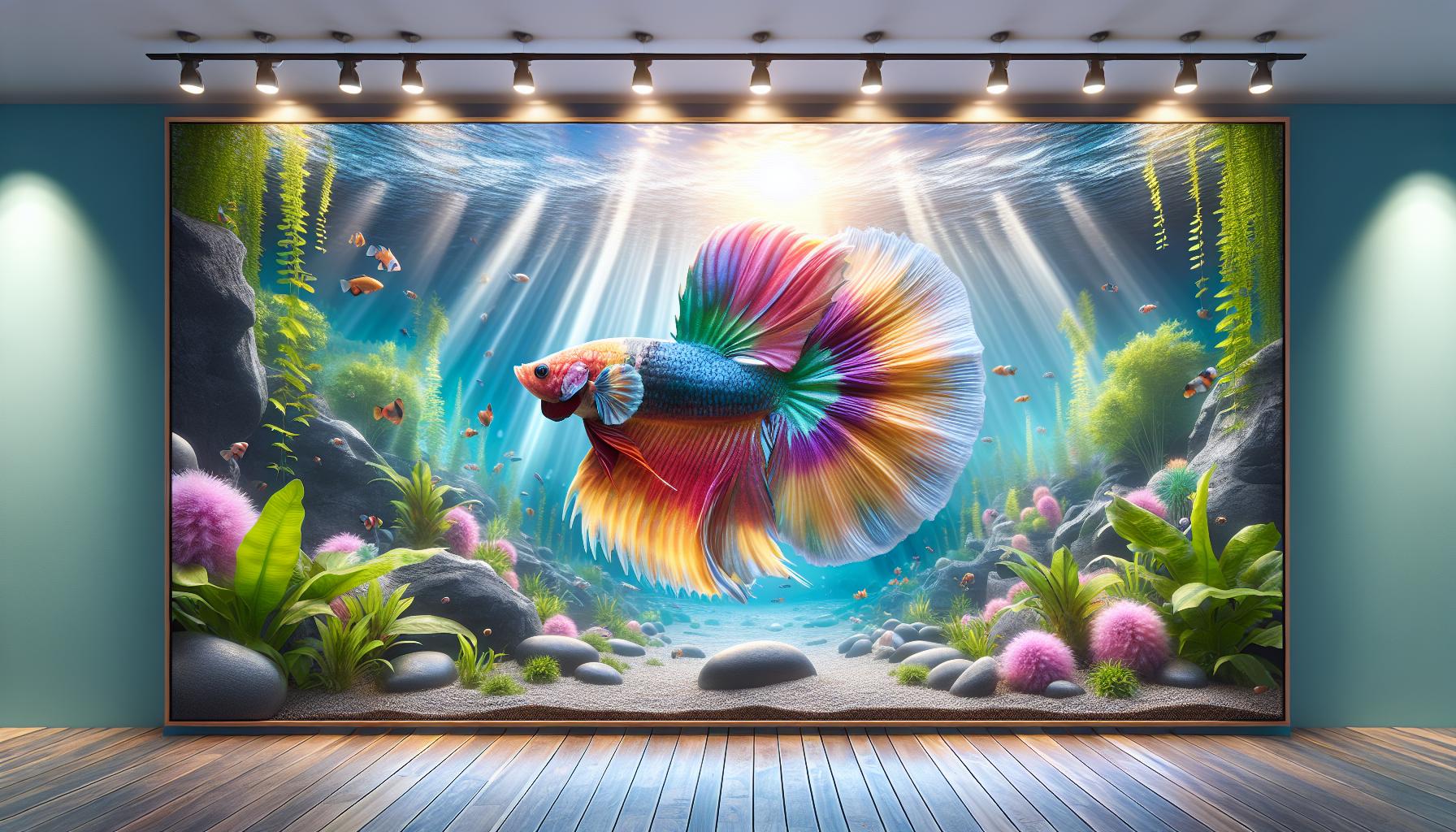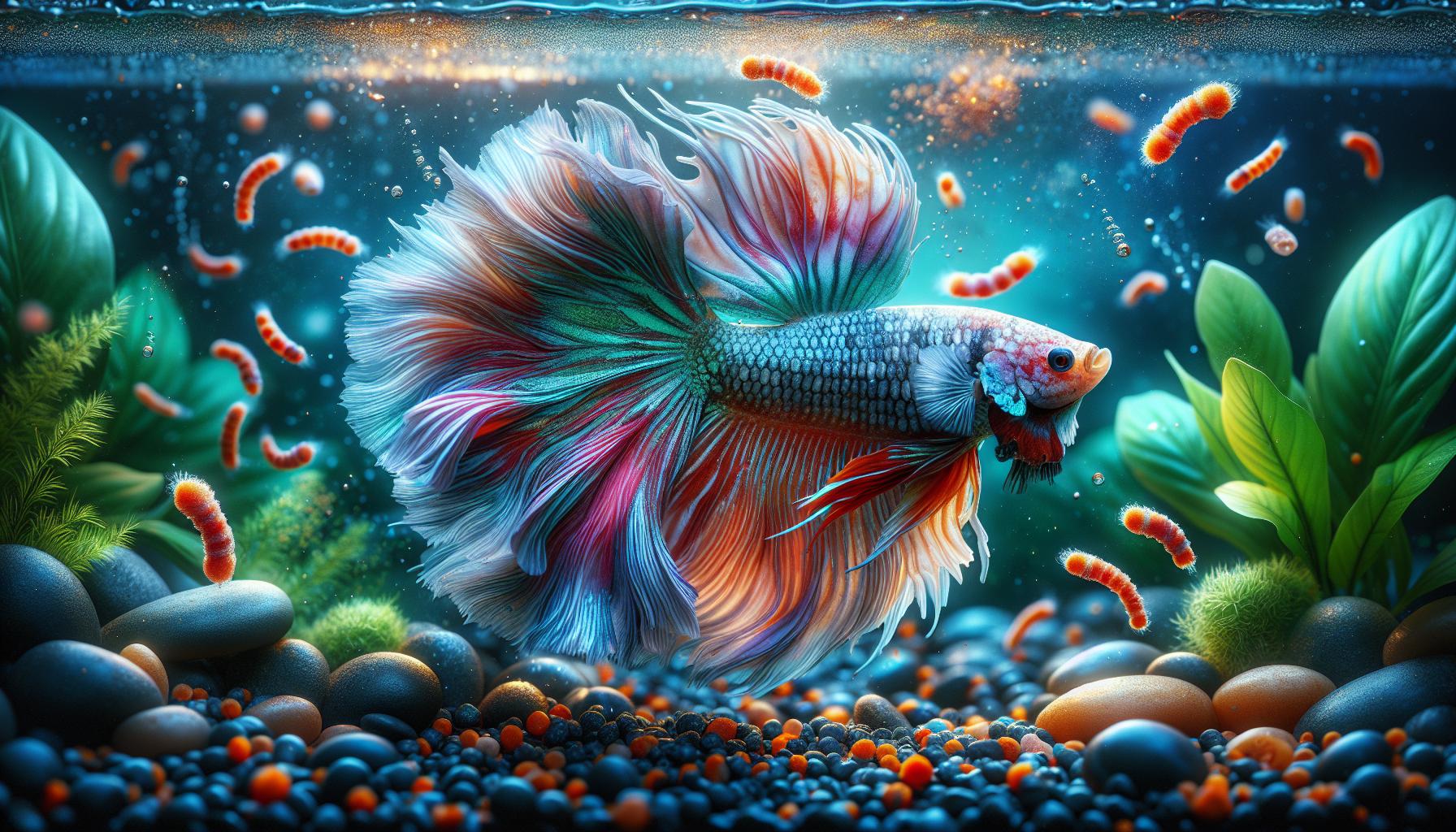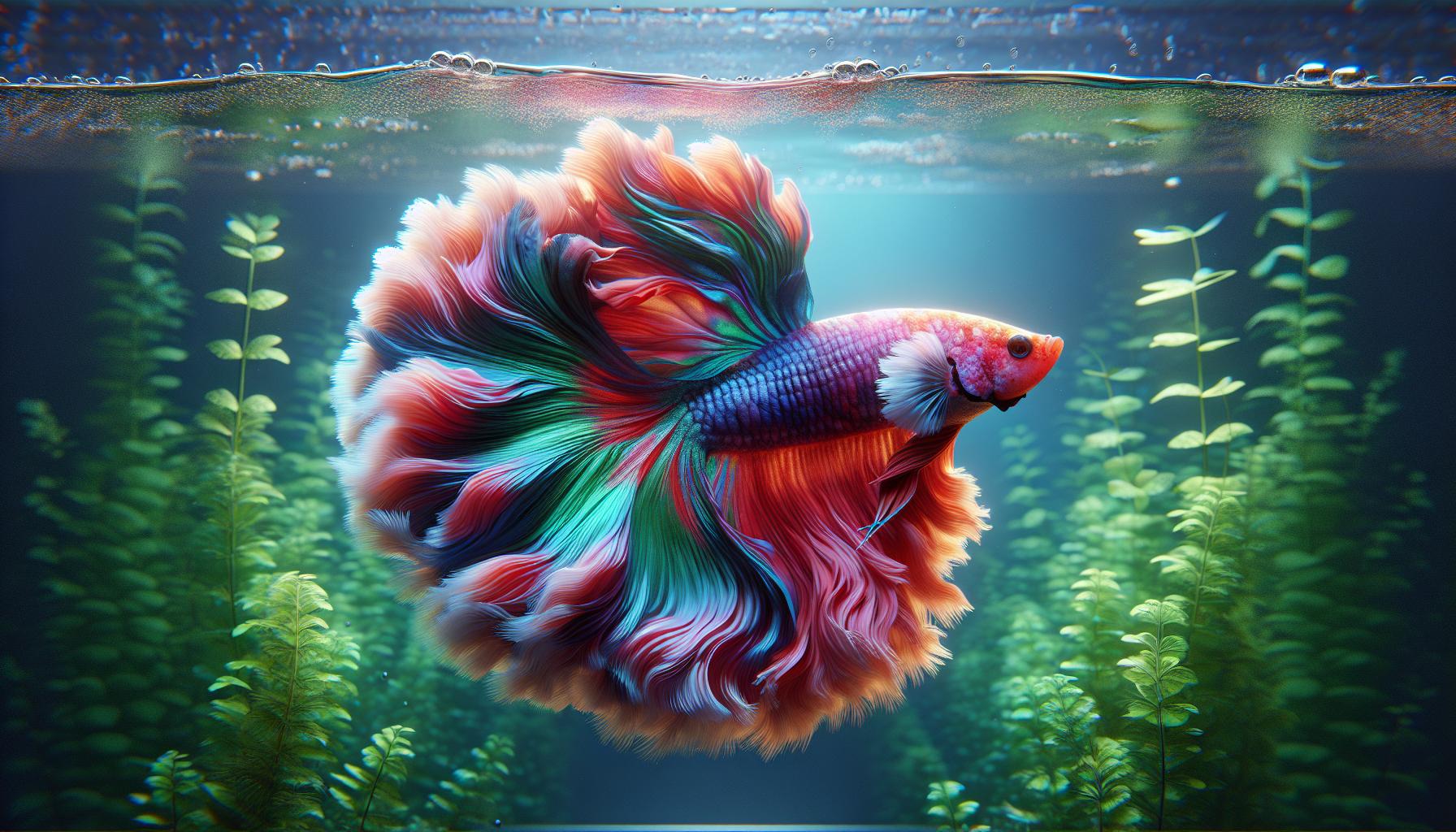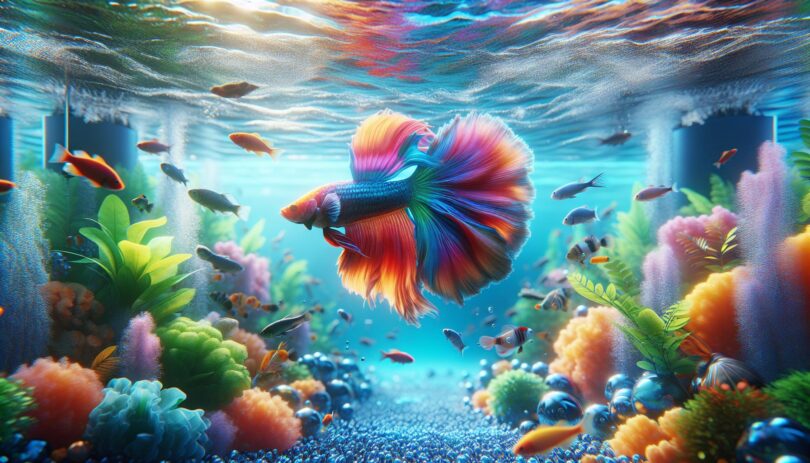Betta fish, with their vivid colors and elegant fins, have captivated my attention and that of many aquarists around the world. These small but mighty creatures are more than just pets; they’re a vibrant addition to any home aquarium.
I’ve found that caring for betta fish is both a rewarding and enlightening experience. They’re known for their unique personalities and ease of care, making them perfect for both novice and experienced fish keepers. Let’s dive into the fascinating world of betta fish and discover what makes them such a popular choice among aquarium enthusiasts.
History and Origins of Betta Fish
I’ve always found the history of betta fish fascinating. Originating from the warm, shallow waters of Southeast Asia, specifically in countries like Thailand, Cambodia, and Vietnam, these fish have a story that’s as colorful as their appearance. Originally living in rice paddies, drainage ditches, and slow-moving streams, betta fish are adapted to environments that are often low in oxygen. This adaptation led them to develop a unique organ known as the labyrinth organ, which allows them to breathe air directly from the surface.
Historically, betta fish, also scientifically named Betta splendens, were first caught for their aggression. Local people would organize fights between males, much like cockfights, betting on the outcome. It wasn’t until the 19th century that these magnificent creatures were introduced to the rest of the world. By the early 20th century, they had made their way into the homes and hearts of aquarium enthusiasts globally, not for fighting, but for their splendid colors and finnage.
One intriguing aspect of betta fish history is the evolution of their vibrant colors and large fins. Wild bettas do not exhibit the wide range of colors and fin types seen in today’s pet bettas. Through selective breeding, enthusiasts have developed bettas with a rainbow of colors – from deep blues and vibrant reds to pastel pinks and even metallic hues. Similarly, fin types have evolved, with variations including the veiltail, crowntail, and halfmoon, among others.
The journey of betta fish from a local sport to a beloved aquarium pet highlights not only humanity’s fascination with aquatic life but also our desire to preserve and enhance the beauty of nature. It’s a testament to how betta fish have swum their way into the lore of pet keeping, adapting not just to their natural environments but also to the hearts of those who care for them.
Anatomy and Physical Features of Betta Fish

When observing betta fish, it’s hard not to be drawn to their striking appearance and vibrant colors. I’ve always been fascinated by the variety of hues and the way their fins flow like luxurious gowns in the water. But there’s more to these creatures than meets the eye. Their anatomy is a testament to years of evolution, perfectly adapted to their environment.
Most distinctive is the labyrinth organ, a unique feature that allows betta fish to breathe atmospheric air and survive in low-oxygen water. This organ acts as a sort of lung, which explains how they thrive in stagnant, shallow waters where other fish might struggle. It’s this adaptability that has allowed them to flourish in diverse environments.
Betta fish exhibit a wide range of colors and fin types, thanks to selective breeding. Originally, they were more muted in color, but today, they dazzle in shades of blue, red, gold, and even black. Their fins, too, have been a focus of breeders. The veiltail, crowntail, halfmoon, and plakat are just a few examples of the fin variations created through careful selection.
| Type | Description |
|---|---|
| Veiltail | Long, flowing fins |
| Crowntail | Spiky, rayed fins notable for their dramatic appearance |
| Halfmoon | Fins that form a semicircle, resembling a half-moon |
| Plakat | Shorter, more traditional fins closer to wild ancestors |
Their size typically ranges from 2.5 to 3 inches in length, making them ideal for home aquariums. Despite their aggressive nature towards other males and their territory, betta fish can be quite gentle and even interactive with their human caretakers.
Caring for these magnificent creatures involves understanding not just their physical needs but also their behavioral patterns, which are deeply rooted in their anatomy. The way they flare their gills in defense or how they build bubble nests for their offspring are all behaviors that make betta fish truly intriguing pets.
By delving into their anatomical features, we gain insights into their resilience and the complexity of their world.
Choosing the Right Betta Fish for Your Aquarium

When I started my journey into the world of aquariums, picking the right betta fish was a top priority. With their vibrant colors and dynamic personalities, these fish can truly bring a tank to life. But, with such a variety available, how do you choose the right one for your setup? Here’s what I’ve learned over the years.
Firstly, consider the size of your aquarium. Betta fish thrive in tanks that offer plenty of space to swim. Although they can survive in smaller environments, I’ve found that a tank of at least 5 gallons provides a healthier habitat. This extra space supports their well-being and allows for a more satisfying viewing experience.
Next, let’s talk about appearance. Betta fish come in an astonishing range of colors and fin types. Whether you’re drawn to the elegance of a Veiltail or the dramatic spikes of a Crowntail, there’s a style for every preference. If you’re looking to create a certain aesthetic in your tank, here’s a brief rundown of popular betta varieties:
- Veiltail: Characterized by their long, flowing tails.
- Crowntail: Known for their spiked finnage.
- Halfmoon: These have full, 180-degree tail spreads.
- Plakat: Shorter finned, resembling their wild ancestors.
Pairing your betta with the right tank mates is crucial. While bettas are often seen as solitary, some can coexist with other species. However, it’s essential to avoid fin nippers or overly active fish that might stress your betta. I’ve had success with calm, non-aggressive companions like snails and some types of shrimp.
The labyrinth organ we previously discussed also means bettas need access to the water’s surface. Ensure your tank setup facilitates this, keeping in mind that overly strong currents can hinder their swimming capabilities.
In selecting the perfect betta for your aquarium, it’s not just about picking the most visually appealing one. It’s about understanding the space they’ll inhabit and the care they’ll need. Through consideration of tank size, appearance preferences, and potential tank mates, you can create a harmonious aquatic environment that both you and your betta will enjoy.
Setting Up the Ideal Betta Fish Habitat

Once I’ve chosen the perfect betta fish, my next step is to set up an ideal habitat that ensures my finned friend thrives. Creating a stress-free environment for betta fish is crucial, as it directly impacts their health and longevity.
The foundation of an ideal betta fish habitat starts with the tank size. Although it’s a common misconception that these fish can live in tiny bowls, I’ve learned that they need space to explore and exercise. A minimum of 5 gallons is what I always aim for, but if I have room, going larger is even better. This extra space doesn’t just support their physical well-being but also helps stabilize water parameters, making the environment safer for them.
Next, I focus on water temperature and filtration. Betta fish are tropical and require warm water between 76 to 82°F for optimal health. I use a reliable aquarium heater and ensure it’s properly calibrated. An adjustable heater is my go-to since it allows me to set the perfect temperature. For filtration, I select a system that offers a gentle flow, as bettas prefer calm waters. This setup mimics their natural habitat, providing a comfortable living space.
Plants and decor play a significant role in replicating a betta’s natural environment. I prefer live plants like java fern and anubias, as they offer hiding spots and reduce stress. When choosing decorations, I make sure they have smooth edges to prevent fin damage. Providing a few hiding places, such as caves or tunnels, encourages natural behaviors and offers a retreat for my betta whenever it feels the need.
Lighting is another aspect I take seriously. Betta fish do not require intense light, so I opt for moderate lighting that mimics daylight without causing stress. This also supports live plants, creating a balanced ecosystem within the tank.
By focusing on these critical components, I’ve successfully created a serene and healthy habitat for my betta fish. Each element, from the water conditions to the tank’s interior, contributes to a thriving environment where my betta can live happily.
Proper Nutrition and Feeding for Betta Fish

When it comes to keeping betta fish healthy and vibrant, proper nutrition cannot be overstated. I’ve found through my years of fishkeeping that bettas require a diet rich in protein. This stems from their carnivorous nature in the wild, where they feed on insects and larvae. A well-rounded diet ensures their striking colors remain vivid and supports overall health.
For optimal nutrition, I recommend a combination of high-quality betta pellets and live or frozen foods such as bloodworms, daphnia, or brine shrimp. It’s essential to choose pellets formulated specifically for bettas, as these typically contain the right balance of protein, fats, and vitamins. Here’s a quick rundown of a balanced feeding schedule I’ve used with success:
- Betta Pellets: Once or twice a day, with the quantity based on the size of the fish. A good rule of thumb is to feed an amount they can consume within 2 minutes.
- Live or Frozen Foods: Two to three times a week as a supplement to the pellets. This not only enriches their diet but also provides necessary enrichment.
It’s noteworthy to mention the risk of overfeeding. Betta fish have small stomachs, roughly the size of their eye. Overfeeding can lead to health issues such as obesity and water quality deterioration. I always remind fellow enthusiasts to remove any uneaten food after feeding time to maintain a clean and healthy tank.
Incorporating a day of fasting each week has also shown benefits in preventing constipation and bloating, two common issues in bettas. This practice gives their digestive system a chance to rest and process any excess food.
By adhering to these feeding guidelines and adjusting as necessary for your betta’s unique needs, you’ll contribute significantly to their health and longevity. Balancing high-quality commercial food with the nutritional variety of live or frozen options creates the perfect regime for these beautiful fish.
Maintaining Water Quality for Betta Fish
Maintaining pristine water quality is paramount for betta fish, just as proper nutrition is. I’ve found that bettas thrive in clean water, which significantly reduces their stress levels and susceptibility to diseases. Here, I’ll dive into how to keep your betta’s environment optimal.
First and foremost, regular water changes are a must. I recommend changing 20-25% of the water in your betta’s tank once a week. It’s imperative to treat new water with a dechlorinator since chlorine and chloramines can harm your betta. This regular schedule helps manage ammonia, nitrites, and nitrates, which can be detrimental at high levels.
Another crucial aspect is maintaining the right water temperature. Bettas are tropical fish and require a stable temperature between 78°F and 80°F. I advise using a reliable aquarium heater and regularly checking the temperature with a thermometer. Fluctuations in temperature can make bettas susceptible to stress and illness.
It’s also vital to monitor the pH level of the water. Ideal conditions for bettas have a pH level ranging from 6.5 to 7.5. I recommend using a pH testing kit weekly to ensure the water remains within this range. Sudden shifts in pH can be harmful, so it’s wise to make adjustments gradually.
- Weekly water changes: Change 20-25% of the tank’s water.
- Temperature maintenance: Keep water between 78°F and 80°F.
- pH level management: Ensure the water’s pH is between 6.5 and 7.5.
Employing a filter in your betta’s tank can greatly assist in maintaining water quality by aerating the water and removing excess food and waste. However, ensure the water flow is gentle to avoid stressing your betta, as they prefer calm waters.
Finally, keeping an eye on your betta’s health and behavior can provide early signs that the water quality might be off. If you notice any unusual behaviors or signs of distress, it might be time to test the water and make necessary adjustments. By following these guidelines, you can create a thriving environment for your betta fish.
Common Diseases and Health Issues in Betta Fish

Understanding common diseases and health issues in betta fish is crucial for any betta owner. I’ve encountered these issues first-hand and have learned the most effective ways to treat them. Betta fish, with their vibrant colors and elegant fins, are also susceptible to several health problems. Knowing what to look out for can make all the difference in maintaining your betta’s health.
First, fin rot is a frequent problem caused by poor water quality, leading to the edges of the betta’s fins fraying or rotting away. It’s often the first sign of an issue and can be treated by improving water conditions and, in severe cases, administering antibiotics.
Another condition to be aware of is Ich or white spot disease, characterized by tiny white cysts on the fish’s body and fins. Ich is highly contagious and requires immediate treatment with over-the-counter medications and potentially increasing the water temperature slightly to speed up the life cycle of the parasite.
Swim bladder disorder is also common, affecting a betta’s ability to swim properly. This can be caused by overfeeding, constipation, or poor water quality. Treatment often involves fasting the fish for a couple of days and then feeding it a boiled pea, which acts as a laxative.
Here’s a quick rundown of these diseases:
| Disease | Causes | Treatment |
|---|---|---|
| Fin Rot | Poor water quality | Improved water, antibiotics |
| Ich (White Spot) | Parasite | Medications, increase water temp |
| Swim Bladder | Overfeeding, constipation | Fasting, boiled pea |
Monitoring your betta’s health isn’t just about responding to diseases but also about preventing them. Regular water changes, a balanced diet, and monitoring for signs of stress can prevent many of these issues. Keeping an eye out for unusual behavior or changes in appearance is key.
Breeding Betta Fish: A Step-by-Step Guide
Breeding betta fish can be a rewarding experience, but it’s crucial to understand the process and prepare adequately to ensure the safety and health of both the fish and their offspring. As someone deeply invested in the well-being of these magnificent creatures, I’m here to guide you through the essential steps of breeding betta fish.
First off, selecting the right pair is key. Look for healthy, vibrant fish that display good genetics and desirable traits. I usually recommend picking a male and female that are about the same size and have compatible temperaments. It’s not just about appearance; health and vigor are paramount.
Next, prepare the breeding tank. A 10-gallon tank works well for this purpose, equipped with a heater to maintain a stable temperature between 78 to 80 degrees Fahrenheit and a low-flow water filter to keep conditions pristine without disturbing the breeding pair or their nest. Adding live plants and hiding spots can replicate their natural environment and provide necessary support for the female.
Conditioning the breeding pair is an often overlooked yet critical step. For a week leading up to the introduction, feed them high-quality, varied diets including live or frozen foods like brine shrimp or bloodworms. This not only boosts their health but increases their fertility.
Introduce the pair to the breeding tank, with a transparent barrier between them initially. This allows them to see and get accustomed to each other without the risk of premature aggression. Monitor their behavior closely; when you notice flaring fins and dancing movements from both sexes, it’s a sign they’re ready.
Finally, the breeding process begins. Remove the barrier carefully. The male will start building a bubble nest, where the eggs will be stored post-spawning. Post-spawning, it’s crucial to remove the female to prevent aggression from the male, who will take over the care of the eggs and eventual fry.
Breeding betta fish involves careful planning, patience, and a willingness to learn from each attempt. Monitoring water quality and maintaining the right conditions in the breeding tank are crucial for the eggs to hatch and the fry to thrive.
Enhancing the Beauty of Betta Fish with Tank Decorations
When I started keeping betta fish, I quickly learned that the right tank decorations don’t just make the environment more appealing for us, but they also enrich the lives of these stunning creatures. Not all tank decorations are created equal, and choosing the right ones can dramatically highlight the vibrant colors and elegant movements of betta fish.
First off, live plants are a must-have in any betta tank. They provide not only a natural and engaging environment for the betta but also help maintain water quality by absorbing nitrates. Some of my personal favorites include java fern and anubias, which are easy to care for and don’t require extensive lighting. These plants offer a lush backdrop, making the iridescent colors of the betta fish pop.
Another aspect to consider is the use of soft silk or live plants over plastic ones. Betta fish have delicate fins that can easily be torn by sharp edges. I’ve found that silk plants mimic the natural feel and resistance of real plants, providing a safe and stimulating space for bettas to explore without the risk of injury.
Caves and hideouts are not just decorations; they’re essential for betta fish to feel secure and reduce stress. A simple coconut shell or a ceramic cave gives bettas a place to retreat, mimicking their natural habitats. Watching a betta fish dart in and out of these hideouts can be quite entertaining and adds a dynamic element to the tank’s landscape.
Lastly, choosing the right substrate can enhance the aesthetic of the tank while being practical. Darker substrates tend to make betta fish colors stand out more. However, it’s essential to select smooth-edged substrates to avoid injuring the fish.
Incorporating these elements into a betta fish tank not only promotes the well-being of the fish but also creates a stunning visual display. The vivid colors of the betta against the rich, textured backdrop of carefully selected decorations make for a captivating view, elevating the overall experience of keeping these enchanting creatures.
Betta Fish Myths and Misconceptions
When it comes to betta fish care, there’s a sea of myths and misconceptions that can lead potential fish owners astray. I’ve encountered several of these misconceptions firsthand and it’s crucial to set the record straight for the well-being of these vibrant creatures.
First up, the myth that bettas can live in tiny bowls. It’s a common belief that bettas thrive in small spaces because of their natural habitats in rice paddies. However, rice paddies offer much more space and environmental complexity than a tiny bowl. Betta fish actually need at least a 5-gallon tank with proper filtration and heating to stay healthy and active.
Another pervasive myth is that bettas don’t require a heater. Originating from tropical Thailand, bettas are accustomed to warm water temperatures between 76°F and 82°F. Keeping them in colder environments can lead to lethargy and health issues. So, a heater isn’t just a luxury; it’s a necessity for their survival.
Feeding misconceptions also run rampant. Many think bettas can sustain themselves on plant roots or are fine with sporadic feeding. In reality, bettas are carnivores requiring a diet rich in protein. Quality betta pellets, along with frozen or live brine shrimp and bloodworms, should constitute their daily feeding to ensure they receive the necessary nutrients.
Lastly, the idea that bettas prefer isolation is misleading. While it’s true males can be territorial and shouldn’t be housed together, bettas can coexist with certain peaceful fish species and invertebrates. This companionship can stimulate their environment and reduce stress, contrary to the belief that they must live in solitude.
By debunking these myths, I aim to encourage better care practices among betta fish owners.
Conclusion
Caring for betta fish goes beyond the common myths that have long circulated among enthusiasts. Understanding their need for space, warmth, proper diet, and companionship is crucial for their well-being. I’ve shared insights to help debunk these myths, aiming to foster a healthier, happier life for these vibrant creatures. Remember, the key to thriving betta fish lies in informed, attentive care. Let’s commit to providing the best environment for our aquatic friends, ensuring they live their lives to the fullest.
Frequently Asked Questions
Do bettas need a large tank to live?
Bettas need at least a 5-gallon tank with proper filtration and heating, not the tiny bowls often marketed for them. This ensures they have enough space to swim and maintain healthy water quality.
Is a heater necessary for a betta fish tank?
Yes, betta fish require a heater because they thrive in warm water temperatures between 76°F and 82°F. Consistent, appropriate water temperature is crucial for their health.
What kind of diet is ideal for bettas?
Bettas are carnivores that need a diet rich in protein. A variety of high-quality betta pellets or flakes, along with occasional live or frozen treats like brine shrimp or bloodworms, is ideal.
Can betta fish live with other species?
While bettas are often thought to prefer isolation, they can live with certain peaceful fish species and invertebrates. It’s important to choose tank mates carefully to avoid aggression and ensure a harmonious tank environment.

